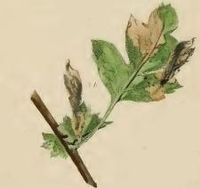ar
الأسماء في صفحات التنقل


Coleophora siccifolia is a moth of the family Coleophoridae. It is found in most of Europe.
The wingspan is 10–12 mm (0.39–0.47 in).[2] Coleophora species have narrow blunt to pointed forewings and a weakly defined tornus. The hindwings are narrow-elongate and very long-fringed. The upper surfaces have neither a discal spot nor transverse lines. Each abdomen segment of the abdomen has paired patches of tiny spines which show through the scales. The resting position is horizontal with the front end raised and the cilia give the hind tip a frayed and upturned look if the wings are rolled around the body. C. siccifolia characteristics include head light greyish-ochreous. Antennae white, ringed with fuscous, basal joint pale greyish-ochreous. Posterior tarsi grey-whitish. Forewings brownish-grey, somewhat shining. Hindwings rather dark grey.[3]
The larvae feed on Alnus, Betula lutea, Betula pubescens, Carpinus betulus, Crataegus laevigata, Malus domestica, Sorbus aucuparia and Tilia species. They create a tubular leaf case. It is almost barrel-shaped, with a large leaf fragment that, while withering, folds itself around the tube. Before a larva leaves a mine to start a new one, it often detaches the upper epidermis by cutting along the sides of the mine. The detached epidermis either falls off or dries and curls.[4] Full-grown larvae can be found in August in Great Britain and in October in continental Europe.
Coleophora siccifolia is a moth of the family Coleophoridae. It is found in most of Europe.
 Hawthorn leaves eaten by the larva, with two cases attached
Hawthorn leaves eaten by the larva, with two cases attached  Larva
Larva The wingspan is 10–12 mm (0.39–0.47 in). Coleophora species have narrow blunt to pointed forewings and a weakly defined tornus. The hindwings are narrow-elongate and very long-fringed. The upper surfaces have neither a discal spot nor transverse lines. Each abdomen segment of the abdomen has paired patches of tiny spines which show through the scales. The resting position is horizontal with the front end raised and the cilia give the hind tip a frayed and upturned look if the wings are rolled around the body. C. siccifolia characteristics include head light greyish-ochreous. Antennae white, ringed with fuscous, basal joint pale greyish-ochreous. Posterior tarsi grey-whitish. Forewings brownish-grey, somewhat shining. Hindwings rather dark grey.
The larvae feed on Alnus, Betula lutea, Betula pubescens, Carpinus betulus, Crataegus laevigata, Malus domestica, Sorbus aucuparia and Tilia species. They create a tubular leaf case. It is almost barrel-shaped, with a large leaf fragment that, while withering, folds itself around the tube. Before a larva leaves a mine to start a new one, it often detaches the upper epidermis by cutting along the sides of the mine. The detached epidermis either falls off or dries and curls. Full-grown larvae can be found in August in Great Britain and in October in continental Europe.
De grote bladkokermot (Coleophora siccifolia) is een vlinder uit de familie kokermotten (Coleophoridae). De wetenschappelijke naam is voor het eerst geldig gepubliceerd in 1856 door Stainton.
De soort komt voor in Europa.
Bronnen, noten en/of referentiesColeophora siccifolia é uma espécie de mariposa do gênero Coleophora pertencente à família Coleophoridae.[1]
Coleophora siccifolia é uma espécie de mariposa do gênero Coleophora pertencente à família Coleophoridae.
Coleophora siccifolia là một loài bướm đêm thuộc họ Coleophoridae. Nó được tìm thấy ở hầu hết châu Âu.
Ấu trùng ăn Alnus, Betula lutea, Betula pubescens, Carpinus betulus, Crataegus laevigata, Malus domestica, Sorbus aucuparia and Tilia.[3] Full-grown larvae can be được tìm thấy ở tháng 8 in Great Britain and in tháng 10 in continental Europe.
Coleophora siccifolia là một loài bướm đêm thuộc họ Coleophoridae. Nó được tìm thấy ở hầu hết châu Âu.
Sải cánh dài 10–12 mm.
Ấu trùng ăn Alnus, Betula lutea, Betula pubescens, Carpinus betulus, Crataegus laevigata, Malus domestica, Sorbus aucuparia and Tilia. Full-grown larvae can be được tìm thấy ở tháng 8 in Great Britain and in tháng 10 in continental Europe.